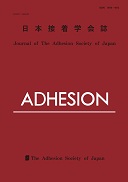All issues

Volume 47, Issue 9
Displaying 1-5 of 5 articles from this issue
- |<
- <
- 1
- >
- >|
Review
-
Motohiro YAMAMOTO, Kenichiro YAMAUCHI, Nagao HORI, Akiko OKUDA2011Volume 47Issue 9 Pages 369-377
Published: September 01, 2011
Released on J-STAGE: August 24, 2016
JOURNAL FREE ACCESSDownload PDF (3342K)
Review
-
Hirofumi NISHIDA2011Volume 47Issue 9 Pages 361-368
Published: September 01, 2011
Released on J-STAGE: August 24, 2016
JOURNAL FREE ACCESSDownload PDF (2894K)
Review
-
Yoshinobu NAKAMURA, Yuji NISHIDA, Syuji FUJII2011Volume 47Issue 9 Pages 354-360
Published: September 01, 2011
Released on J-STAGE: August 24, 2016
JOURNAL FREE ACCESSDownload PDF (2706K)
Original Pepar
-
Isao ICHIKAWA, Kaisuke YANAGIMOTO, Masaaki FURUDATE, Mikihiro KASHIO, ...2011Volume 47Issue 9 Pages 335-343
Published: September 01, 2011
Released on J-STAGE: June 30, 2014
JOURNAL FREE ACCESSVarious components of organic and inorganic compounds are used and connected through the proper procedures in a semiconductor package.Especially,semiconductor devices of metal silicon,printed circuit board (P.C.B.), and accessories are adhered each other by die bond material which are mainly consisted of organic material. The adhesion of the components is known to effect on the reliability of the devices. This lead to develop the new die bond materials including epoxy thermoset systems in which silane coupling agents are added to improve adhesive strength,and some of those are commerdaily available.On the basis of the information mentioned above,a new epoxy thermoset system,in which several silane coupling reagents are added into the die bonding materials containing phosphine and imidazole compounds as the curing accelerators,are examined here. The effects of the additives on adhesive properties are discussed in the aspects of reactivity of the functional groups in the silane couplers through electric charge distribution of the each molecules.View full abstractDownload PDF (3285K)
Original Pepar
-
Yoshinobu NAKAMURA, Yu SAKAI, Keiko ITO, Keigo IMAMURA, Syuji FUJII, Y ...2011Volume 47Issue 9 Pages 344-353
Published: September 01, 2011
Released on J-STAGE: June 30, 2014
JOURNAL FREE ACCESSInfluences of the compatibility of apolyacrylic block copolymer/tackifier blend on the phase structure of the tackifier and adhesion properties of the blend were investigated. For this purpose,special rosin ester resins with different weight average molecular weights of 650,710,890 and 2160 were used as the tackifier and blended with apolyacrylic block copolymer consisting of poly(methyl methacrylate) and poly(n-butyl acrylate) blocks at tackifier content levels of 10,30 and 50 wt%. The compatibility decreased with an increase in molecular weight. It was confirmed by transmission electron microscopic observation that agglomerates of the tackifier of several tens ofnanometers in size formed,with the number of agglomerates increasing with increasing molecular weight of the tackifier (in the range from 650 to 890) and tackifier content. For a molecular weight of 2160, micrometer-sized agglomerates were observed. Dynamic mechanical analysis indicated that both the glass transition temperature and the storage modulus at low temperature increased with addition of the tackifier,and these effects became more pronounced with an increase in the molecular weight of the tackifier and tackifier content in the molecular weight range from 650 to 890. These effects were lower, however,when the molecular weight was 2160. Tack was measured using a rolling cylinder tack tester over wide temperature and rolling rate ranges, and master curves were prepared in accordance with the time-temperature superpositionlaw. The rolling rate at which tack began to appear shifted to a lower rate with an increase in molecular weight of the tackifier and was lowest for amolecular weight of 890. The effect was again reduced,however,for the tackifier with a molecular weight of 2160. It was found that the formation of agglomerates of the tackifier of several tens of nanometers in size aided in development of the storage modulus of the adhesive, and as a result the tack at lower rolling rates increased.View full abstractDownload PDF (3735K)
- |<
- <
- 1
- >
- >|